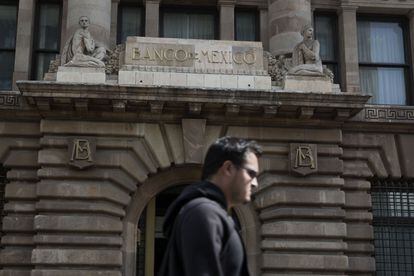A pedestrian walks in front of the Banco de México headquarters in downtown Mexico City.Susana Gonzalez (Bloomberg)
The increase in the reference interest rate in Mexico of 75 basis points, announced on Thursday by the central bank, represents the largest increase since the current monetary policy was established in 2008. This places the rate at 7.75%, close to of the historical maximum 8.25%.
If the forecasts of analysts who expect the Bank of Mexico to apply another increase of 75 points in its decision in August are fulfilled, the rate would reach the highest level in its history.
Faced with inclement inflation, largely caused by exogenous factors, the monetary authority has only had to put a brake on cheap credit as a measure to “cool down” the economy.
A high rate has also helped preserve the appetite of international investors, who buy Mexican debt because it offers a yield well above debt in developed countries.
In the United States, where the economy is closely linked to financial channels, the rise in its rate has raised fears of a recession and the markets have reacted accordingly.
so far this year, the S&P 500 index is down almost 20%.
But this is not the case in Mexico, says Joel Virgen, an analyst at consultancy Out of the Box Economics in New York.
"Taking into account that the country has a low penetration in the banking sector, really the people who have access to consumer or mortgage credit are very limited," says Virgen.
This has to do with the fact that about 56% of the Mexican economy is informal and is not banked.
History also shows that monetary policy decisions in Mexico begin to influence the economy of ordinary citizens in a horizon of between 12 and 18 months.
“It does not have an instantaneous effect, but rather a gradual one”, explains Virgen.
The reference interest rate works as an instrument of influence on the rates used in the financial system and impact the economy.
Discounting expected inflation, the "real" rate, as it is known, is 2.8%, says Virgen, so monetary policy is not considered to be restrictive yet.
This is not the perspective of Mexican President Andrés Manuel López Obrador, who on Friday lashed out against the central bank's decision.
"I respect the autonomy of the Bank of Mexico, but the technicians should already think of another formula," he said at a press conference.
“Because they are not only the technicians of the Bank of Mexico, they are those of the Treasury [in the US], they are all the central banks of the world.
When there is inflation, the formula is: increase interest rates, everywhere”.
Between the lines, the president expressed his frustration with the fact that, in order to lower inflation, economic activity has to be limited.
“It's like when you have a car that overheats;
walks, but gets hot.
Well, that's inflation, the one that the car heats up.
So, so that the car does not heat up, it turns off and it no longer runs, there is no growth.
That is the great invention, that is why I am talking about technicians who think they are scientists,” he told reporters at the National Palace.
“No government is going to be happy with monetary policy actions just when you are in an interest rate hike cycle,” says Virgen, “first, because in some other way it is going to affect growth downwards;
and second, because it will increase the cost of public financing”.
And the inflation picture is not improving.
“We expect Banxico co de México to raise another 75 basis points in August, a 50-point increase in September and then 25-point increases in November and December to place the overnight interest rate target at 9.5% by the end of December. year,” analyst Carlos Capistrán, chief economist for Mexico and Canada at Bank of America, wrote in a report on Friday.
”We do not expect hikes (or cuts) in 2023. We do not rule out the possibility of an intra-meeting decision in the following months to align Banxico's calendar with that of the Fed. In our opinion, the risks in each decision are to the upside” .
A word in the Bank of Mexico statement was very instructive for the market, when it comes to the direction of inflation.
At the meeting in May, the bank's governing board, headed by Governor Victoria Rodríguez Ceja, assured that the balance of risks for inflation had an upward bias.
In the statement released this week, the bank added a key qualification, saying: "The balance of risks to the expected path of inflation over the forecast horizon is skewed to the upside."
“The use of the word 'considerable' is very important because it recognizes the current problems of central banks around the world”, says Virgen, “they are behind inflation in more ways than one.
But there are still no signs that inflation is beginning to moderate and even less that it is beginning to decline”.
subscribe here
to the
newsletter
of EL PAÍS México and receive all the informative keys of the current affairs of this country

